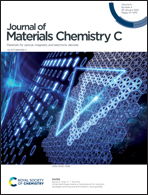Assessing the stability of Cd3As2 Dirac semimetal in humid environments: the influence of defects, steps and surface oxidation†
Abstract
The presence of a Dirac cone in bulk cadmium arsenide (Cd3As2) has triggered the interest of the scientific community, considering its technological potential related to the ultrahigh mobility of charge carriers and the observed giant magnetoresistance. Definitely, the stability of Cd3As2 in humid environments is crucial for a successful technology transfer. Here, we study the interaction of Cd3As2 with water by means of density functional theory and surface-science experimental tools. Metastable water adsorption is feasible for both pristine and defective surfaces with Cd and As vacancies. Water decomposition is energetically favorable only at steps, although with a rate of only ∼0.1 s−1 at atmospheric pressure, with H and OH fragments forming bonds with As and Cd atoms, respectively. Interestingly, surface oxidization notably increases the reactivity towards water, also enabling water decomposition on the oxidized Cd3As2(112) surface with a rate of ∼108 s−1 and an energy barrier of only 0.29 eV. Our study clarifies the key role of surface oxidation in the interaction of Cd3As2 with water molecules, and, consequently, also in the stability of Cd3As2 in humid environments (including air). Moreover, our results elucidate the need of encapsulation in order to protect the surface of Cd3As2 topological semimetal from oxidation and hydroxylation. Correspondingly, it is evident that the wetting properties of this topological material drastically depend on the presence of surface oxide phases.



 Please wait while we load your content...
Please wait while we load your content...